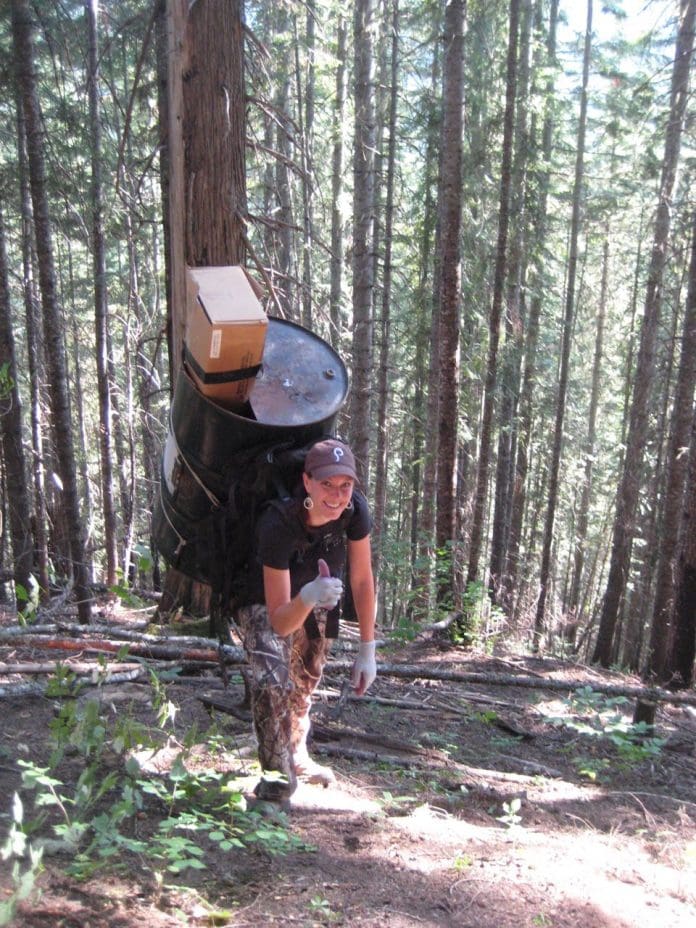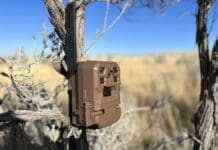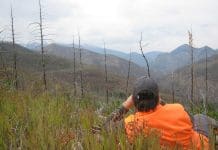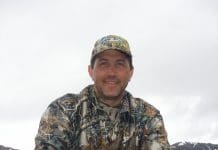Bear Baiting 101
by Amy Hanneman
One of the highlights each year for me is spring Black Bear hunting season. I have been baiting bears in Idaho for many years and it is something that I have become very passionate about. Baiting for bear may sound simple, but it is actually a difficult and arduous task that requires a lot of dedication, patience, and a relatively good state of physical fitness (you may be packing up to 60 lbs. of bait up very steep mountains). Packing a lot of weight into steep and rugged country is a good reason to stay in top physical condition. I rarely hunt from a tree stand, but this is one area where I make an exception.
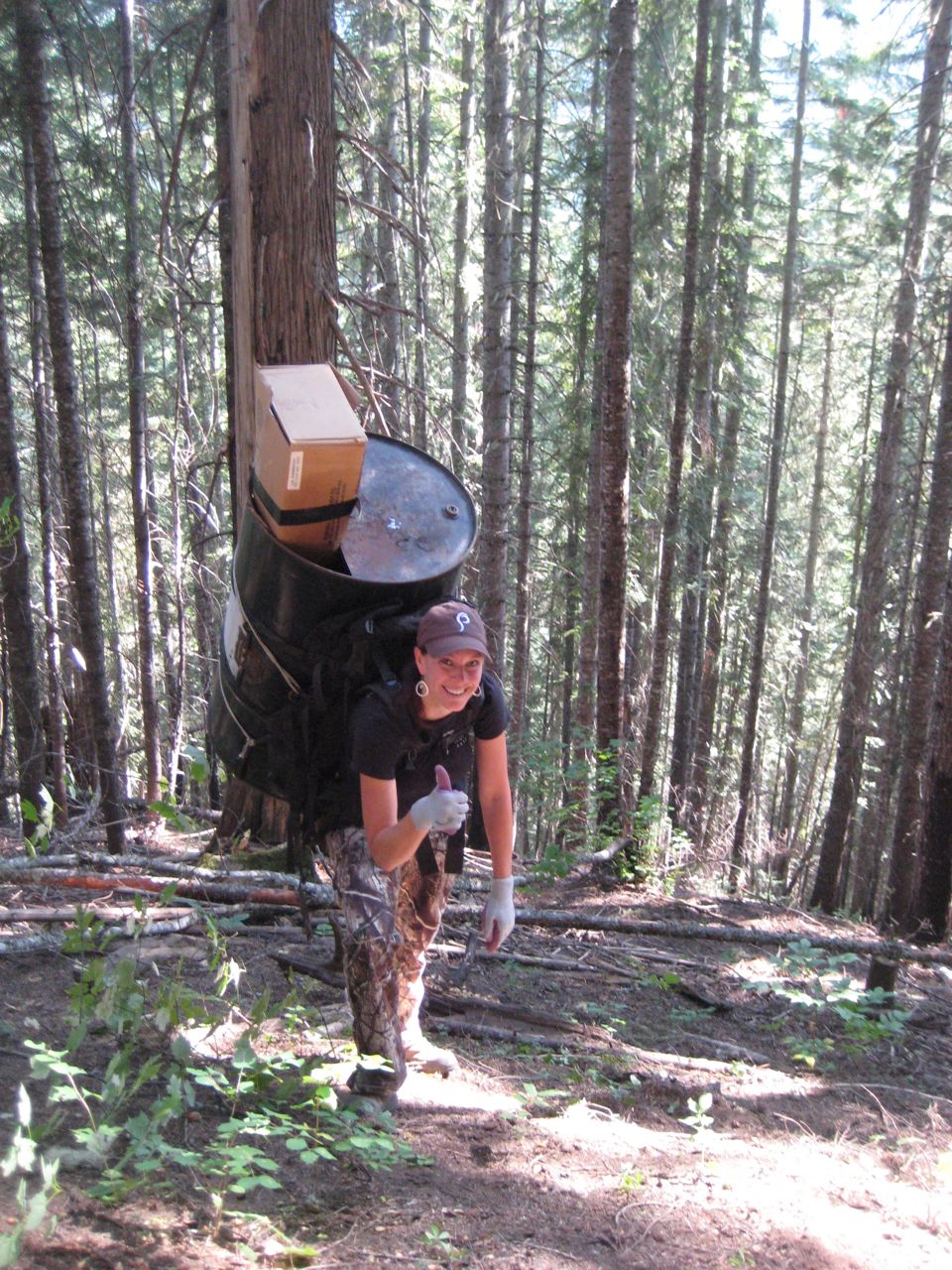 I began my bear baiting career by committing myself to research. It is important to know which states will allow baiting and which will not. For example, Montana is my home state but it does not allow baiting, so I am limited to using Wyoming and Idaho as my options for running bait sites. Since I only live thirty five miles from the Idaho border, the decision of where to bait was easy for me. I encourage anyone hunting and baiting to check out the state’s website for their regulations. For this article my focus will be on Idaho since it is very familiar to me.
I began my bear baiting career by committing myself to research. It is important to know which states will allow baiting and which will not. For example, Montana is my home state but it does not allow baiting, so I am limited to using Wyoming and Idaho as my options for running bait sites. Since I only live thirty five miles from the Idaho border, the decision of where to bait was easy for me. I encourage anyone hunting and baiting to check out the state’s website for their regulations. For this article my focus will be on Idaho since it is very familiar to me.
Idaho’s spring bear season is April 1st to June 30th and the fall season is August 30th to November 3rd. It is a requirement to purchase a hunting license of $154.75, a bear baiting permit of $31.75, and 1-2 bear tags at $31.75 (reduced tag). The bear baiting permit allows me to run up to three bait sites.
The next step is to build up some barrels. I prefer to take a fifty five gallon barrel and cut a 6” X 6” square hole about one third up the side for a standing barrel. I will cut off one third of the lid if I am going to set the barrel in a lying down position. It really depends on the location of the site to determine which way I will set up my barrel. Idaho only allows one barrel at each bait location.
Now comes the fun part- determining what to use for bait. My preference is to use bread, doughnuts and other bakery items that I cover in grease. I really don’t think bears are that picky as long as the food is not moldy or stale. I have used dog food, three-way molasses grain, apples, left-overs (lucky for my kids), candy and anything else that may be lying around not getting eaten by my family. In fact, one year my husband had one piece of the birthday cake I made for him and then told me I could use the rest as bear bait! I can’t decide if he didn’t like it or if he just liked it so much that he thought he would eat it all if he didn’t get rid of it. I have never asked, since I really don’t want any more confirmation on my poor culinary skills!
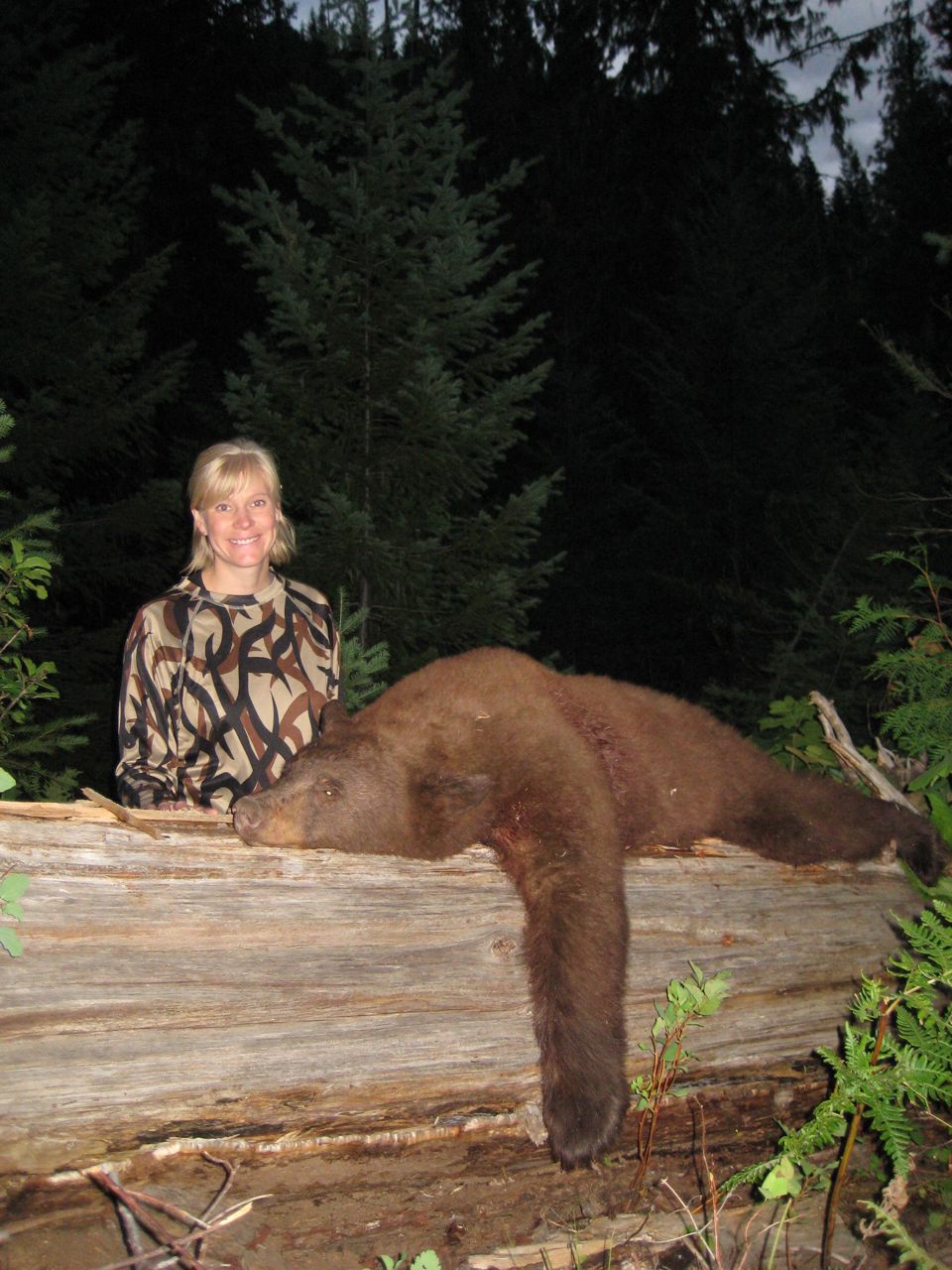 Once I have my license, baiting permit, tags, barrels and bait I am finally ready to head into the mountains. I try to look for a baiting area in rougher country farther away from the roads. This helps eliminate some of the pressure of hunting on public land. Baiting on a ridge allows scent to carry up and down a mountain 24/7. I also think it is important to set the bait up within 400 yards of water. When setting up my bait I make sure I chain the barrel to a tree so the hole in the barrel is at a ninety degree angle from where my tree stand will be placed. This will put a feeding bear broadside to the shooter. I will then place a few small logs in the hole of the barrel and larger logs up against the barrel. This way the bear will have to work to get the bait and will also keep smaller animals from stealing the bait. For attractant I sometimes will hang a beaver up in a tree and will use a trapping scent called “O’Gorman’s Long Distance Call” to help draw bears in. To add extra olfactory teasing I will burn honey and molasses each time I bait. I will burn one cup of each ingredient down to the ashes, and I think it works great as an attractant. I make it a point to bait two times a week until the bears are cleaning out the barrel consistently and then I will sometimes bait every other day.
Once I have my license, baiting permit, tags, barrels and bait I am finally ready to head into the mountains. I try to look for a baiting area in rougher country farther away from the roads. This helps eliminate some of the pressure of hunting on public land. Baiting on a ridge allows scent to carry up and down a mountain 24/7. I also think it is important to set the bait up within 400 yards of water. When setting up my bait I make sure I chain the barrel to a tree so the hole in the barrel is at a ninety degree angle from where my tree stand will be placed. This will put a feeding bear broadside to the shooter. I will then place a few small logs in the hole of the barrel and larger logs up against the barrel. This way the bear will have to work to get the bait and will also keep smaller animals from stealing the bait. For attractant I sometimes will hang a beaver up in a tree and will use a trapping scent called “O’Gorman’s Long Distance Call” to help draw bears in. To add extra olfactory teasing I will burn honey and molasses each time I bait. I will burn one cup of each ingredient down to the ashes, and I think it works great as an attractant. I make it a point to bait two times a week until the bears are cleaning out the barrel consistently and then I will sometimes bait every other day.
Once the baits are set up and running I will then hang a trail camera at each site. I want to know what, when and how big when it comes to observing my sites. I found out the hard way that getting a bear box for the trail camera is a good investment. I also wear gloves when removing the SD card to keep any bait scent off of it since bears seem to love to rip it apart if they can.
Next, I hang two tree stands at each site since we do try to video our hunts. Although, this last year I did about 80% of my bear hunting solo it is still nice to have an extra tree stand in case you want to invite someone along. The stands are placed 20 yard on average from the bait. Hanging the stand facing up the ridge on a north facing slope allows you to see what is coming and also gives you a more level angle for a shot. It also allows you to use the thermal air current in the evening to keep your wind right. A good rule of thumb is to never climb into a stand until the thermals have switched and there is a steady downhill breeze, and always use a scent killer spray along with keeping clothes and boots clean.
My rule is that I will not hunt a site until I have had a bear worth killing on my trail camera for at least three days in a row during daylight hours. By following this rule I have about an 80% chance of killing that bear the first time I sit in the stand. I think it is wise to keep the human scent at the bait site to a minimum so I will not just sit a site with the hopes that something will “happen” to show up. I definitely do not consider myself an expert on hunting black bear, but this method seems to have worked for me over the years.
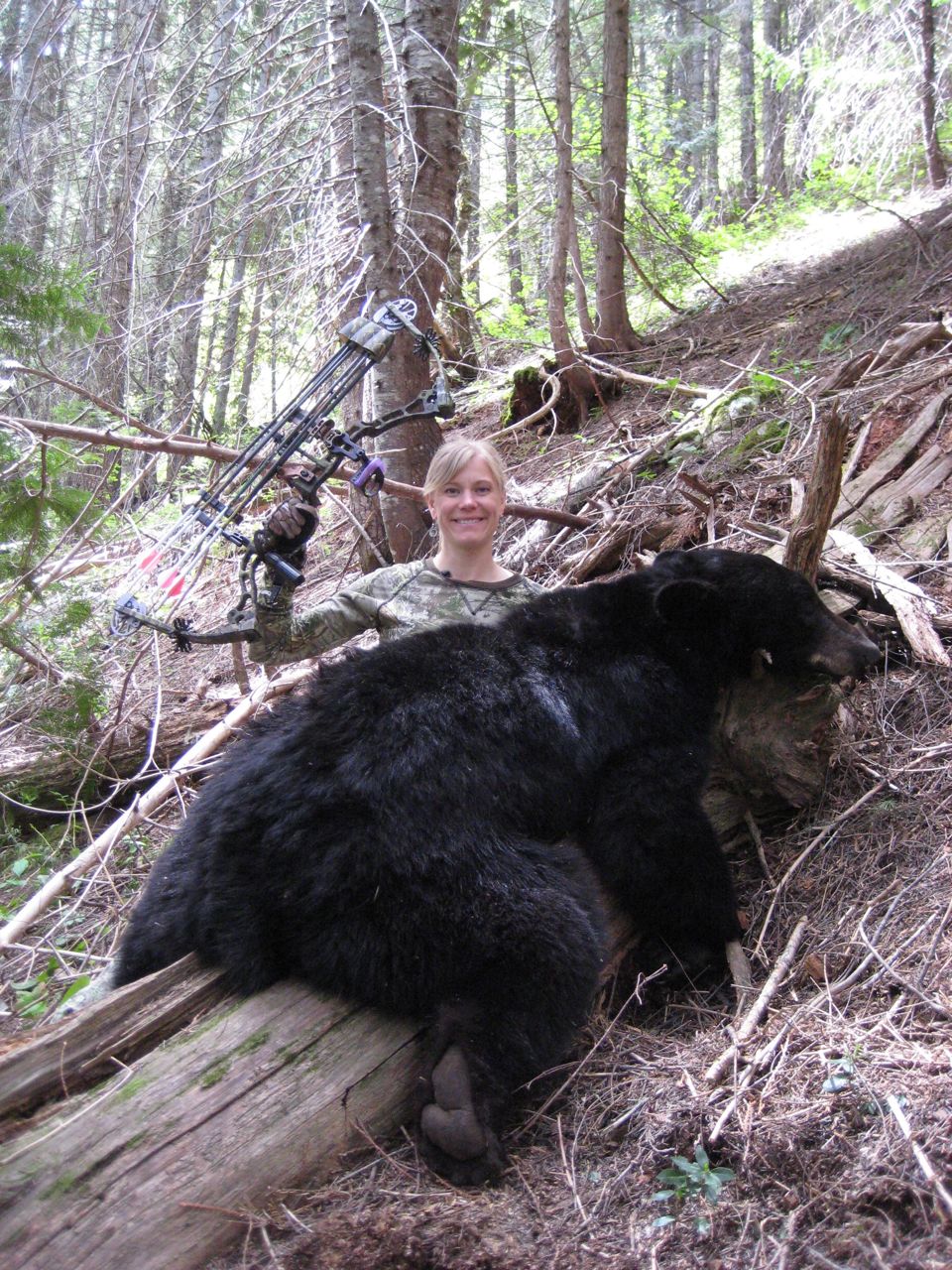 One of the biggest highlights for me is seeing what is on my trail camera each time I bait. I have pictures of mule deer, whitetail deer, elk, marten, fisher, and a whole lot of crows. It is also fun to watch different bears grow from year to year. One of the great things about the area I hunt is that about 40% of the black bear I see are color phase bears.
One of the biggest highlights for me is seeing what is on my trail camera each time I bait. I have pictures of mule deer, whitetail deer, elk, marten, fisher, and a whole lot of crows. It is also fun to watch different bears grow from year to year. One of the great things about the area I hunt is that about 40% of the black bear I see are color phase bears.
There was a grizzly killed in the area where hunt a few years ago, so be sure of what species you are shooting. The hunter that shot the bear was on a guided hunt and was dropped off at the bait. The bear came in and he shot it thinking it was a color phase Black bear. The Idaho Fish and Game confiscated the bear and the hunter was fined. My advice is that if you are hunting in Montana, Idaho or Wyoming, know exactly what kind of bear you are shooting. Grizzly bear populations seem to be doing extremely well and they are expanding their range every year.
I look forward each year to baiting for bears since it is such an incredibly satisfying hunt when it all comes together. I am already counting down the days until April 1st!














